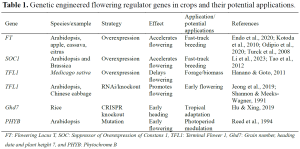Have you ever wondered how farmers manage to harvest crops at the perfect time each year? One of the key secrets lies in controlling when plants flower—and modern science is now giving us powerful tools to fine-tune this process.
Flowering is the gateway to fruit, seed, and the next generation of plants. But it’s also a puzzle shaped by day length, temperature, internal plant signals, and even stress. In the wild, this ensures survival. In agriculture, it can be a bottleneck for breeding and productivity—especially as climate change scrambles natural rhythms.
Why Flowering Time Matters
Getting the timing right can mean the difference between a bumper crop and a failed harvest. For breeders, especially those working with fruit trees or tropical crops that take years to flower, waiting for the plant to bloom naturally is painfully slow.
That’s where biotechnology comes in.
Scientists Hack the Floral Clock
Thanks to advances in molecular biology, researchers have uncovered the genes that act as the plant’s internal calendar. One of the most important is FT, nicknamed “florigen.” This gene acts like a green light for flowering. When scientists increase the activity of FT, plants flower earlier—even skipping years of waiting in long-lived crops like apple and cassava.
Other genes like SOC1 and LFY help reinforce this push toward flowering. On the flip side, repressors like TFL1 and Ghd7 act like brakes, delaying flowering. By turning these genes off using CRISPR or RNA interference, researchers can encourage plants to flower sooner—or manipulate the timing to match local climates.
From Lab to Field: Fast-Track Breeding
These breakthroughs have led to “fast-track breeding” methods. Imagine developing six generations of wheat or rice in a single year instead of just one! Using FT-based genetic tweaks and indoor speed breeding systems, scientists can slash breeding timelines and respond more quickly to challenges like drought or new pests.
And it’s not just about speed. In crops grown for their leaves, roots, or stems—like spinach, cassava, or bioenergy grasses—delaying flowering allows them to bulk up before diverting energy to reproduction. By tweaking floral genes, farmers can grow bigger plants and harvest more biomass.

But There Are Caveats
Flowering isn’t just about pretty blooms. It’s tied to pollinators, seasonal cycles, and ecosystem balance. Changing the flowering time too much can confuse bees or expose crops to unexpected frosts or droughts. There are also regulatory hurdles and public concerns about genetically modified organisms (GMOs).
That’s why scientists are now exploring more precise tools, like using heat or light triggers to control gene expression, or limiting changes to specific tissues or stages.
What’s Next?
Future research is looking beyond big-name crops to include tropical, orphan, and underutilized plants—helping farmers worldwide adapt to changing environments. And by connecting flowering genes with those that regulate stress responses or nutrition, we may soon breed crops that are not only timely bloomers but also climate-smart and super-nutritious.
Polosoro, A. (2025). Modulating flowering for breeding efficiency and biomass optimization: A molecular and biotechnological review. Buitenzorg: Journal of Tropical Science, 2(1), 13–26. https://doi.org/10.70158/buitenzorg.v2i1.18

